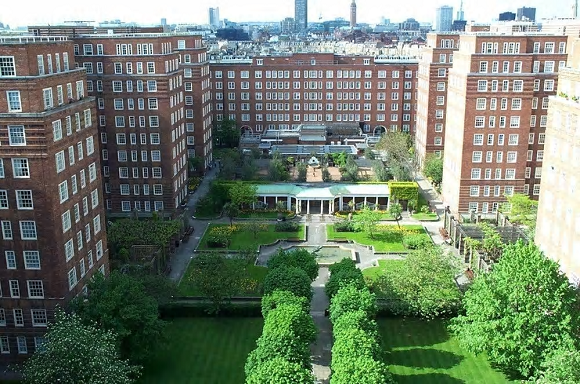This website uses cookies
This website uses cookies to enable it to function properly and to analyse how the website is used. Please click 'Close' to accept and continue using the website.



The C20 Society is pleased that the planning application to significantly alter Dolphin Square was turned down at Westminster’s Planning Committee this week. But we remain vigilant to proposals to change a large part of the fabric of this landmark block of private flats near the River Thames at Pimlico in London – including plans to reconfigure apartments, demolish historic areas and create a new nine-storey building – and we believe these changes would cause harm to the significance of the Dolphin Square Conservation Area.
Dolphin Square is of substantial historic and architectural significance as an impressive large-scale self-contained urban living typology which was pioneering for its day in the UK. Indeed, it remains unusual. The brainchild of New York property developer Fred French, who aimed to import the concept of serviced apartments from the US to the UK, Dolphin Square’s remit was to provide high standard to middle and lower income groups. French couldn’t fund the project, and it went forward with designs by Gordon Jeeves for Richard Rylands Costain and was built between 1935 and 1937, with the consulting engineer being reinforced concrete expert Oscar Faber. With 1,236 flats it was the largest self-contained block of flats in Europe and occupied 7.5 prime acres facing the Thames.
Planned in 13 wings or ‘houses’, all named after famous admirals and navigators, at ten storeys (apart from Dolphin House, previously known as Rodney, at six storeys) its massive scale gave it an unquestionably imposing urban character. Inside is five miles of corridors. Its external design includes gardens and a recreational centre and underground garage. The ground floor of Roland House still contains an intact internal parade of shops and the swimming pool, designed by Edward Irvine Halliday (1902-84), featured a 90-foot mural in map form depicting historical events on the Thames (since covered) and was embellished with a brass dolphin. The gardens were designed by Richard Suddell, then President of the Institute of Landscape Architects, to include two main lawns flanking an avenue of chestnut trees, a rose garden, fountain and pool.
The Square was instantly renowned and early advertisements for the Square boasted of “London’s Largest and Best Equipped flats”. The Promotional Booklet told of “a city of 1,250 flats, each enjoying… most of the advantages of the separate house and the big communal dwelling place.” The provision of amenities such as the restaurant prompted the contemporary concern that “fortunate wives will not have enough to do. The Dolphin lady may be spoiled!”
Over the years Dolphin Square acquired a colourful social history. Being close to government buildings it has housed over 70 politicians including Harold Wilson, David Steel and William Hague, royals such as Anne, Princess Royal, and a more notorious cast of residents including Christine Keeler, Mandy Rice-Davies, Oswald Mosley and his wife Diana Mitford. John Vassall, the Soviet spy, was arrested here. It was the base for de Gaulle’s Free French in the Second World War and MI5 based a section in the building.
Dolphin Square was architecturally influential and Patrick Hodgkinson acknowledged its influence on his designs for the Brunswick Centre. To date it is little changed, appearing much as it did in the 1930s, and is externally intact.
Although our attempts to achieve national listing were not successful, Dolphin Square is nevertheless recognised as a heritage asset as it forms the majority of the built area of the Dolphin Square Conservation Area designated in 1990. The Gardens are registered on the Parks and Gardens Register at Grade II. In the proposals for alteration, the demolition of Rodney House would represent the loss of a substantial amount of the conservation area – as would the demolition of the top storey and replacement with two unmatching new storeys, the loss of the historic shopping parade and original recreational centre and some garden areas.
The Society is pleased that the council has pushed back on the proposals. We maintain that these plans cause harm to the conservation area and this non-designated heritage asset and we will continue to argue the case to retain Dolphin Square in its current form.
By Clare Price, head of casework, the C20 Society

Become a C20 member today and help save our modern design heritage.